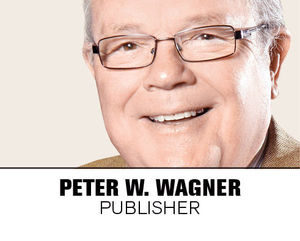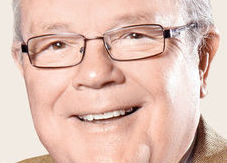By Peter W. Wagner
Whenever the conversation turns to printed newspaper vs. digital publication my comment is always the same: The delivery platform isn’t as important as the information being delivered.
In an age when almost any obscure fact can be found on the Internet, it is locally written content – innovative, interesting and motivating news stories that attract readers.
 There are two kinds of stories: Hard news and features. The first includes covering the city council and the second is writing about a kid in a wheelchair playing grade school basketball. Coupled with both those kinds of stories there should also be an abundance of local, full color photos, interactive columns and lots of ads. Many subscribers buy a paper as much for the ads as they do the editorial content.
There are two kinds of stories: Hard news and features. The first includes covering the city council and the second is writing about a kid in a wheelchair playing grade school basketball. Coupled with both those kinds of stories there should also be an abundance of local, full color photos, interactive columns and lots of ads. Many subscribers buy a paper as much for the ads as they do the editorial content.
But back to editorial content and an important truth: The community newspaper is the first writer of local history. Reporters are the early contributors for articles and books that will be written generations from now. In the newspaper you see drafts covering events as simple the vote at last night’s city council meeting, the basketball team’s three overtimes before winning Friday night’s game, the birth of a son or daughter at the hospital, the opening of a new street front business or the death of a long admired, or almost unknown, resident.
Your readers want to be regularly updated on the activities of local people, emerging and historic places, annual events and community government and organizations. They want to get that information from sources they can trust. They want more than a single website paragraph, they want the “who, what, where, when and why” of traditional, professional journalism.
Not every story has to be long to carry the weight of importance. Often pertinent information can be reported in a well-thought-out graphic. They should do more than fill space. They should tell a moving story all by themselves. They should be sharp, well edited and print boldly on the page.
Here are some places my son Jay P. Wagner often told our N’West Iowa REVIEW staff to look for story ideas:
- The classified ads in our newspaper and other regional papers.
- The bulletin boards at the local grocery store, city hall, bowling alley or high school.
- Student newspapers, church bulletins, employee newsletters, chamber and city newsletters and all of the hundreds of news releases that hit your desk. But don’t print the news release as it come in. Find an original story within the information and write a superior piece different from the release printed by all your competition.
- Have coffee with the businessmen who meet at the drug store every weekday morning. Say little and keep your ears open. You’ll learn a great deal about a great deal of things going on in the community.
- Pay as much attention to what is talked about before and after the council or supervisors meeting as what is said at the meeting itself. Sometimes the best story pops up outside of the official discussion.
- Drive to work along a different route every morning. You’ll be surprised what you’ll discover.
- Be nice to secretaries and gatekeepers. They’ll often tell you more than you’ll ever get from their bosses.
Jay and Jeff Grant, his successor as editor of The N’West Iowa REVIEW, would also suggest that most failing newspapers have at least two of three reoccurring problems. The first is that many fail to have any recognizable personality. Their story selection and publication design are very limited.
The second is the publishers refuse to listen to the requests and suggestions of their subscribers.
Third, and most important of all, they don’t regularly publish an opinion page. They fail to provide a credible forum for public expression.
Being the best requires a desire to excel by both the management and the staff. It demands a heavy investment in technology and qualified employees. It depends on a consistent mentoring program and committed newsroom leadership.
And most of all, it requires personal passion from the top down. A passion driven by the love of sharing the community’s story – and getting it right.
 Nevada Press Association The best in Nevada journalism since 1924
Nevada Press Association The best in Nevada journalism since 1924
